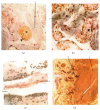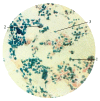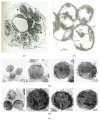Primo-Vascular System as Presented by Bong Han Kim
- PMID: 26379743
- PMCID: PMC4562093
- DOI: 10.1155/2015/361974
Primo-Vascular System as Presented by Bong Han Kim
Abstract
In the 1960s Bong Han Kim discovered and characterized a new vascular system. He was able to differentiate it clearly from vascular blood and lymph systems by the use of a variety of methods, which were available to him in the mid-20th century. He gave detailed characterization of the system and created comprehensive diagrams and photographs in his publications. He demonstrated that this system is composed of nodes and vessels, and it was responsible for tissue regeneration. However, he did not disclose in detail his methods. Consequently, his results are relatively obscure from the vantage point of contemporary scientists. The stains that Kim used had been perfected and had been in use for more than 100 years. Therefore, the names of the stains were directed to the explicit protocols for the usage with the particular cells or molecules. Traditionally, it was not normally necessary to describe the method used unless it is significantly deviated from the original method. In this present work, we have been able to disclose staining methods used by Kim.
Figures







Similar articles
-
50 years of bong-han theory and 10 years of primo vascular system.Evid Based Complement Alternat Med. 2013;2013:587827. doi: 10.1155/2013/587827. Epub 2013 Jul 31. Evid Based Complement Alternat Med. 2013. PMID: 23983793 Free PMC article.
-
Primo Vascular System: A Unique Biological System Shifting a Medical Paradigm.J Am Osteopath Assoc. 2016 Jan;116(1):12-21. doi: 10.7556/jaoa.2016.002. J Am Osteopath Assoc. 2016. PMID: 26745560 Review.
-
Historical observations on the half-century freeze in research between the Bonghan system and the primo vascular system.J Acupunct Meridian Stud. 2013 Dec;6(6):285-92. doi: 10.1016/j.jams.2013.07.004. Epub 2013 Jul 26. J Acupunct Meridian Stud. 2013. PMID: 24290792 Review.
-
The Cellular Architecture of the Primo Vascular System.J Acupunct Meridian Stud. 2022 Feb 28;15(1):4-11. doi: 10.51507/j.jams.2022.15.1.4. J Acupunct Meridian Stud. 2022. PMID: 35770569 Review.
-
Chronological Review on Scientific Findings of Bonghan System and Primo Vascular System.Adv Exp Med Biol. 2016;923:301-309. doi: 10.1007/978-3-319-38810-6_40. Adv Exp Med Biol. 2016. PMID: 27526157
Cited by
-
Bundle structures inside the deep cervical lymphatic vessels of mice.Sci Rep. 2024 Nov 18;14(1):28449. doi: 10.1038/s41598-024-80155-1. Sci Rep. 2024. PMID: 39558080 Free PMC article.
-
Traditional Acupuncture Meets Modern Nanotechnology: Opportunities and Perspectives.Evid Based Complement Alternat Med. 2019 Jul 16;2019:2146167. doi: 10.1155/2019/2146167. eCollection 2019. Evid Based Complement Alternat Med. 2019. PMID: 31379954 Free PMC article. Review.
-
The concept of biophotonic signaling in the human body and brain: rationale, problems and directions.Front Syst Neurosci. 2025 Jun 23;19:1597329. doi: 10.3389/fnsys.2025.1597329. eCollection 2025. Front Syst Neurosci. 2025. PMID: 40626233 Free PMC article. Review.
-
Various stem cells in acupuncture meridians and points and their putative roles.J Tradit Complement Med. 2018 Apr 3;8(4):437-442. doi: 10.1016/j.jtcme.2017.08.004. eCollection 2018 Oct. J Tradit Complement Med. 2018. PMID: 30302323 Free PMC article. Review.
References
-
- Kim B. H. Study on the reality of acupuncture meridian. Journal of Jo Sun Medicine. 1962;9:5–13.
-
- Kim B. H. On the acupuncture meridian system. Journal of Jo Sun Medicine. 1963;90:6–35.
-
- Kim B. H. The Sanal theory. Journal of Jo Sun Medicine. 1965;108:39–62.
-
- Kim B. H. The Kyungrak system. Journal of Jo Sun Medicine. 1965;108:1–38.
-
- Kim B. H. Sanal and hematopoiesis. Journal of Jo Sun Medicine. 1965;108:1–6.
Publication types
LinkOut - more resources
Full Text Sources
Other Literature Sources

